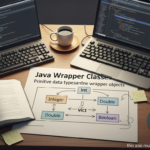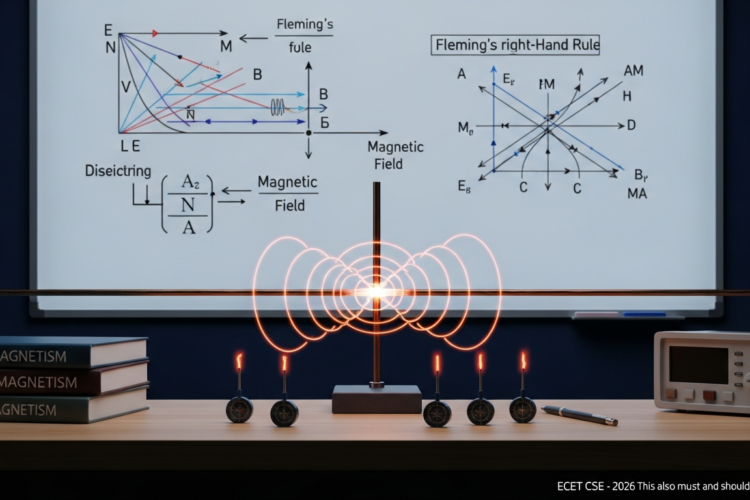
In ECET 2026 for the CSE stream, Java programming is one of the most important areas in the programming section. Among its fundamentals, Control Structures form the backbone of decision-making in code. Understanding if/else and switch statements not only helps in writing efficient programs but also boosts your MCQ score in competitive exams like APECET and TSECET.
📘 Concept Notes – Control Structures in Java
🔹 What are Control Structures?
Control structures in Java determine the flow of execution of a program based on conditions and choices.
1️⃣ if / else Statement
- if checks a condition and executes code if the condition is true.
- else executes code if the condition is false.
- else if is used for multiple conditions.
Syntax:
if (condition) {
// Code if true
} else {
// Code if false
}Example:
int marks = 75;
if (marks >= 50) {
System.out.println("Pass");
} else {
System.out.println("Fail");
}2️⃣ switch Statement
- Used when multiple possible values for a variable need to be checked.
- More readable than multiple else if statements.
- Works with
byte,short,int,char,String, and enums.
Syntax:
switch (variable) {
case value1:
// Code block
break;
case value2:
// Code block
break;
default:
// Code block
}Example:
int day = 3;
switch (day) {
case 1: System.out.println("Monday"); break;
case 2: System.out.println("Tuesday"); break;
case 3: System.out.println("Wednesday"); break;
default: System.out.println("Invalid day");
}💡 Key Points to Remember
- if/else: Best for range checks and complex conditions.
- switch: Best for equality checks against fixed values.
- Always use break in switch to prevent fall-through.
- default case in switch is optional but recommended.
🔟 10 Most Expected MCQs – ECET 2026 [Java – Control Structures]
Q1. Which control structure is best for range checking in Java?
A) switch
B) if/else
C) for loop
D) do-while
Q2. What happens if the break statement is omitted in a switch case?
A) Syntax error
B) Skips the case
C) Executes the next case(s) as well
D) Program stops
Q3. Which data type is NOT supported in a Java switch statement?
A) int
B) String
C) boolean
D) char
Q4. In an if statement, what must the condition evaluate to?
A) int
B) boolean
C) char
D) float
Q5. Which keyword is used to execute code when no cases match in a switch statement?
A) else
B) default
C) break
D) continue
Q6. What will be the output of:
int x = 5;
if (x > 3)
System.out.println("A");
else if (x > 4)
System.out.println("B");A) A
B) B
C) AB
D) No output
Q7. Which is true about switch statements?
A) Only integers allowed
B) String type allowed since Java 7
C) Can only use char and int
D) Cannot have default case
Q8. In Java, the else part of an if/else is executed when:
A) Condition is true
B) Condition is false
C) Syntax error occurs
D) Always executes
Q9. What is the default return type of an if/else block?
A) boolean
B) void
C) None
D) int
Q10. Which of the following will cause a compile-time error in Java?
A) switch on String
B) if on boolean
C) switch on double
D) switch on char
✅ Answer Key Table
| Q.No | Answer |
|---|---|
| Q1 | B |
| Q2 | C |
| Q3 | C |
| Q4 | B |
| Q5 | B |
| Q6 | A |
| Q7 | B |
| Q8 | B |
| Q9 | C |
| Q10 | C |
🧠 Explanations of All Answers
- Q1 → B: if/else is best for range-based conditions.
- Q2 → C: Without
break, execution falls through to the next case. - Q3 → C: boolean is not supported in switch.
- Q4 → B: if conditions must evaluate to boolean.
- Q5 → B:
defaultis used when no case matches. - Q6 → A: First condition true, so prints “A” and skips others.
- Q7 → B: Java 7 introduced String support in switch.
- Q8 → B: else executes only when if condition is false.
- Q9 → C: if/else has no inherent return type.
- Q10 → C: double type not allowed in switch expressions.
🎯 Why This Practice Matters for ECET 2026
Java control structures are high-yield topics in ECET. Questions are often direct and syntax-based, making them easy marks for prepared students. Practicing with real examples and MCQs will ensure you write correct logic in coding questions and answer theory questions accurately.
📲 Join Our ECET Prep Community on Telegram
Get daily coding MCQs, Java notes, and ECET programming practice PDFs.
👉 Join now: @LearnNewThingsHub



